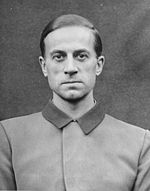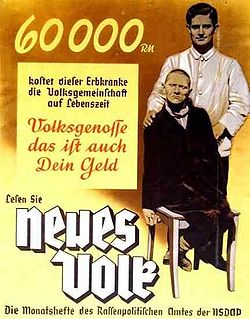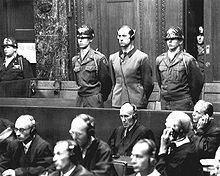- Karl Brandt
-
This article is about the Nazi physician. For the agricultural economist, see Karl Brandt (economist).
Karl Brandt 
Brandt as a defendant at the Doctors' Trial.Born January 8, 1904
MulhouseDied June 2, 1948 (aged 44) Nationality German Known for Reich Commissioner for Health and Sanitation Political party National Socialist German Workers' Party Spouse Anni Brandt, née Rebhorn Children Karl Adolf Brandt Karl Brandt (January 8, 1904 – June 2, 1948) was a German Nazi war criminal. He rose to the rank of SS-Gruppenführer in the Allgemeine-SS and SS-Brigadeführer in the Waffen-SS. Among other positions, Brandt headed the administration of the Nazi euthanasia program from 1939 onwards and was selected as Adolf Hitler's personal physician in August 1934. In 1942, he became Reich Commissioner for Health and Sanitation. He was involved in criminal human experimentation, along with his deputy Werner Heyde and others. After World War II, Brandt was convicted of crimes against humanity. He was hanged on June 2, 1948.[1]
Contents
Early life
Brandt was born in Mulhouse in the then German Alsace-Lorraine territory (now in Haut-Rhin, France), but his parents were not Alsatians[citation needed]. He became a medical doctor in 1928. He joined the Nazi Party in January 1932, and became a member of the SA in 1933. He became a member of the SS in July 1934 and was appointed Untersturmführer. From the Summer of 1934 forward, he was Hitler's "Escort Physician". Karl Brandt married Anni Rehborn (born 1904), a champion swimmer, on March 17, 1934. They had one son, Karl Adolf Brandt (born October 4, 1935).
Career in the Third Reich
 This poster (from around 1938) reads: "60,000 Reichsmarks is what this person suffering from a hereditary disease costs the People's community during his lifetime. Comrade, that is your money too." Read '[A] New People', the monthly magazine of the Bureau for Race Politics of the NSDAP."
This poster (from around 1938) reads: "60,000 Reichsmarks is what this person suffering from a hereditary disease costs the People's community during his lifetime. Comrade, that is your money too." Read '[A] New People', the monthly magazine of the Bureau for Race Politics of the NSDAP."
In the context of the 1933 Nazi law Gesetz zur Verhütung erbkranken Nachwuchses (Law for the Prevention of Hereditarily Diseased Offspring), he was one of the medical scientists who performed abortions in great numbers on women deemed genetically disordered, mentally or physically handicapped or racially deficient, or whose unborn fetuses were expected to develop such genetic "defects". These abortions had been legalized, as long as no healthy Aryan fetuses were aborted.[2]
On September 1, 1939, Brandt was appointed by Hitler co-head of the T-4 Euthanasia Program, with Philipp Bouhler.[3] He received regular promotions in the SS; by April 1944, Brandt was a SS-Gruppenführer in the Allgemeine-SS and a SS-Brigadeführer in the Waffen-SS.[4] On April 16, 1945, he was arrested by the Gestapo for moving his family out of Berlin so they could surrender to American forces. He was condemned to death by a court in Berlin. Brandt was released from arrest by order of Karl Dönitz on May 2, 1945. He was placed under arrest by the British on May 23, 1945.
Life in the Inner Circle
Karl Brandt and his wife Anni were members of Hitler's inner circle at Berchtesgaden where Hitler maintained his private residence known as the Berghof. This very exclusive group functioned as Hitler's de facto family circle. It included Eva Braun, Albert Speer, his wife Margarete Speer, Dr. Theodor Morell, Martin Bormann, Hitler's photographer Heinrich Hoffmann, and Hitler's adjutants (and their wives) and secretaries. As members of this inner circle, the Brandts had a residence near the Berghof and spent extensive time there whenever Hitler was present. In his memoirs, Speer described the familial but numbing lifestyle of Hitler's intimate companions who were forced to stay up most of the night—night after night—listening to the Nazi leader's repetitive monologues or to an unvarying selection of music. Despite Brandt's personal closeness to Hitler, the dictator was furious when he learned shortly before the end of the war that the doctor had sent Anni and their son toward the American lines in hopes of evading capture by the Russians. Only the intervention of Heinrich Himmler and Albert Speer saved Brandt from execution in the war's closing days. However, involvement in euthanasia and human medical experimentation led to his conviction and execution by the Allies on June 2, 1948.[5]
Trial and execution
Brandt was tried along with twenty-two others at the Palace of Justice in Nuremberg, Germany. The trial was officially titled United States of America v. Karl Brandt et al., but is more commonly referred to as the "Doctors' Trial"; it began on December 9, 1946. He was charged with four counts: 1) conspiracy to commit war crimes and crimes against humanity as described in counts 2 and 3; 2) War crimes: performing medical experiments, without the subjects' consent, on prisoners of war and civilians of occupied countries, in the course of which experiments the defendants committed murders, brutalities, cruelties, tortures, atrocities, and other inhuman acts. Also planning and performing the mass murder of prisoners of war and civilians of occupied countries, stigmatized as aged, insane, incurably ill, deformed, and so on, by gas, lethal injections, and diverse other means in nursing homes, hospitals, and asylums during the Euthanasia Program and participating in the mass murder of concentration camp inmates; 3) Crimes against humanity: committing crimes described under count 2 also on German nationals; 4) Membership in a criminal organization, the SS. The charges against him included special responsibility for, and participation in, Freezing, Malaria, LOST Gas, Sulfanilamide, Bone, Muscle and Nerve Regeneration and Bone Transplantation, Sea-Water, Epidemic Jaundice, Sterilization, and Typhus Experiments.
After a defense led by Robert Servatius, on August 19, 1947, Brandt was found guilty on counts 2-4 of the indictment. With six others, he was sentenced to death by hanging, and all were executed at Landsberg Prison on June 2, 1948. Nine other defendants received prison terms of between fifteen years and life, while a further seven were found not guilty.
Brandt's excuse as to his criminal actions at his trial was that,"...any personal code of ethics must give way to the total character of the war".[6]
See also
- Nazi Germany
- Theodor Morell, another personal physician of Hitler.
- Doctors' Trial
References
- ^ Hamilton, Charles (1984). Leaders & Personalities of the Third Reich, Vol. 1, R. James Bender Publishing, p. 138.
- ^ 1935: Das Gesetz zur Änderung des Gesetzes zur Verhütung erbkranken Nachwuchses führt eine von der nationalsozialistischen Haltung zu Eugenik und Sterilisation motivierte Option auf Schwangerschaftsabbruch bei einer zu Sterilisierenden (Sechs-Monats-Fristenregelung) ein. Formale Bedingung für eine straffreie Abtreibung war unter anderem die „Einwilligung der Schwangeren“; in der Praxis dürften die Wünsche und Vorbehalte von als „minderwertig“ definierten Frauen allerdings oft missachtet worden sein.
- ^ Thompson, D.: The Nazi Euthanasia Program, Axis History Forum, March 14, 2004. URL last accessed April 24, 2006.
- ^ Hamilton, Charles (1984), p. 138.
- ^ Hamilton, Charles (1984), p. 138.
- ^ Hamilton, Charles (1984), p. 138.
Further reading
- Schmidt, Ulf, Karl Brandt: The Nazi Doctor: Medicine and Power in the Third Reich (London, Hambledon Continuum, 2007).
Categories:- 1904 births
- 1948 deaths
- People from Mulhouse
- Alsatian-German people
- Action T4 personnel
- Executions by the United States Nuremberg Military Tribunals
- SS generals
- Nazi physicians
- People executed by hanging
- People from Alsace-Lorraine
- Medical practitioners convicted of murdering their patients
- Executed German people
- Health care professionals convicted of murdering patients
- Holocaust perpetrators
- Nazi human experimentation
- Nazi leaders
- Adolf Hitler
Wikimedia Foundation. 2010.

